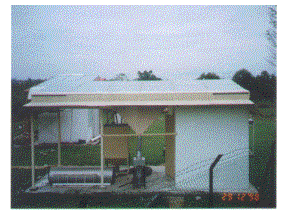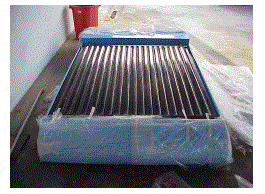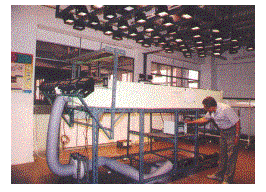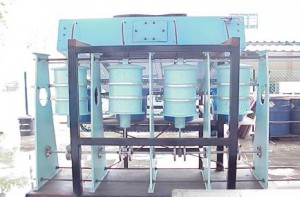Solar Thermal
1. Solar Assisted Drying Systems
The technical development of solar drying systems can proceed in two directions. Firstly, simple, low power, short life, and comparatively low efficiency-drying system. Secondly, high efficiency, high power, long life expensive drying system. The latter is characterized not only by an integrated structure but also integrating in an energy system involving process other than drying such as hot water when the drying system is not in use. In addition, air based solar collectors are not the only available systems. Water based collectors can also be used. A water to air heat exchanger can be used. The hot air that will be used to dry the product can be forced to flow in the water to air heat exchanger. In addition, the hot water tanks of the farm can be used as heat storage of the solar drying system. The solar assisted drying systems are (a) the solar assisted drying systems with the V- grove collector; (b) solar assisted drying systems with the double pass collector and (c) solar assisted dehumidification system. The first two systems are air based solar collector systems and the third is a water based system. The first system has been used for drying chilies and green tea. The second dryer has been used for oil palm fronds (an agricultural waste of the oil palm tree) and the third for medicinal herbs. In addition, a natural convective solar dryer has been tested and evaluated. The systems provide low cost drying system for agricultural and marine products.
2. Innovative Solar Hot Water Heater
The design of the solar heater is of a single unit which include the absorber plate, water tank, heat exchanger, and optional electric heater. The system works with a primary pressureless circuit and a secondary use water circuit. All parts of the body are made out of glass fibre reinforced polyester (GFRP), which is corrosion proof, and of very long lifetime. The design of the body is a sandwich construction with a core material made from polyurethane foam, which combines stiffness of the structure with light weight and a very good thermal insulation. The absorber plate is a separate part. It is to be inserted into the body without any additional fixing or sealing. The absorber plate will also be made from GFRP using a special resin-composition, which provides a very good thermal conductivity and absorptivity.
3. Solar Simulator
The simulator consists of 45 halogen lamps, each with rated power of 300 W. The lamps are arranged in 10 rows on 1.7 m x 3.6 m with each row consists of 5 or 4 lamps with center-to-center distance is about 40 cm. Each lamp is equipped with dimmer in order to sets the lamp’s radiation. The source of electricity is supplied from public electricity line, which is installed in the laboratory. This figure shows arrangement an array of 45 lamps. The simulator may produced varieties of radiation values with small errors. The average radiation is 280 W/m2 to 640 W/m2 with errors about of 3.16 % to 4.05 %.
4. Solar Stirling Engine for Water Pumping
In this project, the focus is set on developing an engine for water pumping facility. Water pumping is a ubiquitous human activity, where the water is pumped for drinking and for domestic, agricultural and industry uses. While the cost of water is directly connected to the required energy for pumping, transmitting and storing water where the common source of energy is electricity, supplying water to remote places and isolated islands could lead to financial concerns to the authority. Since the conventional power grids are not available in such places, the use of motors and generators can solve the problem. However, such units require fuel and frequent maintenance, and with the rise in fuel cost, the pumping operation may not be economical in the long run. If such places received a great deal of solar radiation, an alternative solution is to use the solar energy as the energy source. By using solar-based equipment, the high initial cost of installation is balanced by the low operation and maintenance cost.
5. Solar Air Conditioning System
Absorption air conditioning system differs from vapor compression air conditioning only in the positive pressure gradient stage. In absorption air conditioning system, pressurization is accomplished by first dissolving the refrigerant in a liquid (the absorbent) in the absorber section, then pumping the solution to a high pressure with an ordinary liquid pump. The solar energy is used to heat up the solar collectors. The heat is supplied to the generator to boil off the water vapor (the refrigerant) from a solution of lithium bromide and water. The water vapor is cooled down in the condenser, and then passed to the evaporator where it is again evaporated at low pressure, thereby providing cooling to required space. Meanwhile, the strong solution leaves the generator to the absorber. In the absorber, the strong solution absorbs the water vapor leaving the evaporator. Cooling water from the cooling tower removes the heat by mixing and condensation. Usually an auxiliary energy source is provided, so that the hot water can be supplied to the generator during period of insufficient solar energy.
In the new design, a compact system with integrated solar collector, generator and condenser has been developed. The solution of LiBr and water forms a thin layer in the solar collector absorber plate. The water vapor is collected under the glass cover of the collector and then passes through the evaporator and provides cooling effect. The water from the tank will be sprayed on top of the glass cover and re-circulates. In the absorber, the strong solution absorbs the water vapor leaving the evaporator and the process continues. The COP of the system is 0.30.








